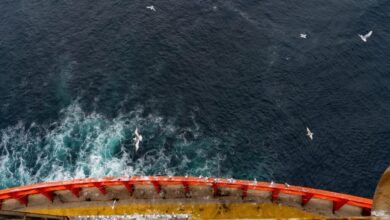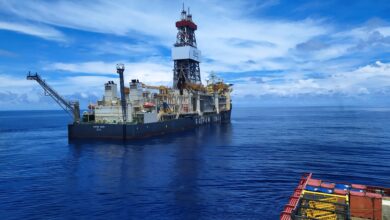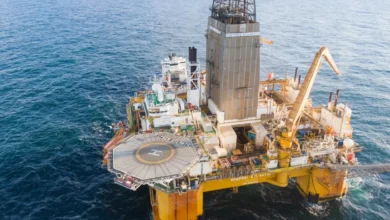Rig demand, dayrate movements point to recovery in North Sea
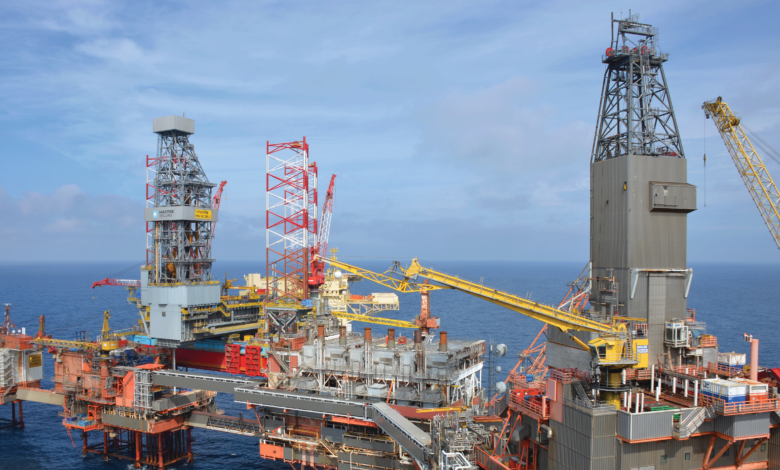
Demand for semisubmersibles proving to be especially strong as operators ramp up development drilling amid stronger oil prices
By Karen Boman, Associate Editor
- Backlog for working harsh-environment semis is growing in Norway, while utilization in UK is “essentially 100%.”
- Dayrates for harsh-environment semis in Norway up to $250,000 from average of $193,000 in 2017.
- Drilling contractors using downturn to reexamine operating practices, update technologies to boost performance.
- Operators cite digitalization, contractor alliances, advanced seismics as among key enablers to keeping per-barrel costs low.
On the horizon for the next year, there are 22 possible drilling programs for the Norwegian North Sea and 43 potential drilling programs in UK North Sea, said Terry Childs, Head of Westwood’s RigLogix Group. “The bottom line is there is quite a bit of potential for semis in the North Sea, and there are a lot of contract awards coming in the near future. This means that some idle rigs will return to work, while other rigs working now will have additional backlog added,” he explained.
In Norway, 13 out of the 23 harsh-environment semis in the country were working as of mid-May, for a total utilization rate of 56.5%. Nine of the 13 working rigs are not available until 2020 or later, Mr Childs pointed out, so the backlog is relatively high. However, there are still five cold-stacked units and two warm-stacked rigs without contracts. The remaining three idle units were expected to start working in June.
Dayrates in Norway have also shown signs of improvement over the past six to 12 months. In 2017, the average dayrate for harsh-environment semis working in Norway was just over $193,000. But from January to mid-May 2018, the average dayrate for harsh-environment semis in Norway was set at $250,000 or more, with one even eclipsing $300,000, said Teresa Wilkie, Senior Rig Market Analyst with Westwood.
A similar trend can be seen in the UK North Sea, where the utilization rate for harsh-environment semis was “essentially 100%” as of mid-May, Mr Childs said. Six of the 11 harsh-environment rigs in the region were working, and four of the five idle rigs – Saipem’s Scarabeo 8, China Oilfield Services’ COSLProspector, Awilco Drilling’s WilPhoenix and Dolphin Drilling’s Blackford Dolphin – were expected to start work shortly. That would mean 10 of the 11 rigs are either contracted or committed for work. Both the Scarabeo 8 and the WilPhoenix have been contracted by Shell, with work starting in June and mid-September, respectively. The COSLProspector is expected to begin work for Nexen in mid-July, and the Blackford Dolphin was expected to start a contract with BP in late May.
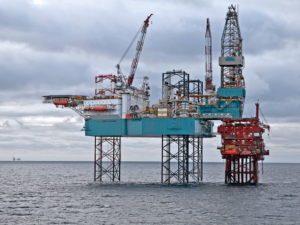
“The lone remaining unit is cold-stacked,” Mr Childs added. Further, although four of these rigs in Norway have contracts ending in 2018, two have options that will likely be exercised, which would keep them working beyond 2018. “This means there are, at most, only two available units the rest of this year,” he said.
UK-based Awilco appears to be betting that harsh-environment semi demand will remain stable or even rise, Mr Childs pointed out, with its March order of a newbuild rig of the Moss Maritime CS60 ECO MW design. Scheduled for delivery in late Q1 2021, the rig will be designed for harsh-environment use and capable of operating in up to 5,000 ft of water on the Norwegian Continental Shelf, including the Barents Sea. The rig will have a variable deckload of 5,000 ton, a hookload of 2 million lb, automated drilling controls and a BOP with five 15,000-psi, 18 ¾-in. rams. The contract between Awilco and Keppel FELS in Singapore provides the option for three more similar units to be built.
As another signal of a rising market, Westwood is also hearing more discussions about drilling contractors reactivating semis. One recent reactivation announcement is Diamond Offshore’s Ocean Endeavor, which is being reactivated for a two-year contract with Shell starting in early May 2019. Ocean Rig’s Eirik Raude semi has also been confirmed for reactivation, which will be completed around Q2/Q3 2019, according to Westwood. “A contract for the rig hasn’t been confirmed yet, but it is likely that they are close to getting a contract or confident in the ever-tightening market that they can secure work for it in the next year,” Mr Childs said. The reactivation of Seadrill’s West Hercules, which was completed in Q1 2018, is another example.
While harsh-environment semis are getting most of the attention in the North Sea, some drilling contractors – such as Rowan Companies and Ensco – have also been testing the pricing of high-spec jackups, which has resulted in a slight increase in dayrates for those units, Ms Wilkie said. She noted, however, that visibility into jackup dayrates is spotty, with many drilling contractors reluctant to discuss such information in a down market.
In terms of drilling programs, operators in the North Sea are likely to continue favoring development drilling over exploration and appraisal drilling. During 2018, Westwood expects that three high-impact exploration wells – defined as those targeting more than 100 million bbl of oil or 1 trillion cu ft of gas – will be drilled in the UK Central/Northern North Sea and the Norwegian North Sea. The wells include Hungary-based oil and gas firm MOL Group’s Driva-Oppdal well in the Norwegian Central North Sea, which is scheduled for drilling in Q3 2018 and will target pre-drill resources estimated at 434 million boe. Also in Q3, Wellesley Petroleum plans to drill the Serin well in the Norwegian Northern North Sea, which the operator estimates holds pre-drill resources of 160 million boe. The third high-impact exploration well planned this year is Eni’s Rowallan well in the UK Central North Sea. Rowallan’s pre-drill resource is estimated at 132 million boe.
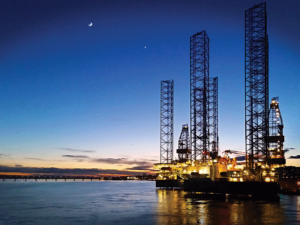
So far this year, two exploration wells have already been drilled in the UK North Sea, which resulted in one commercial oil discovery – Apache Corp’s Garten discovery in Block 9/18a near the Beryl field. Westwood estimates that 10 additional exploration wells and three appraisal wells will be drilled this year in the UK North Sea.
Looking out to 2019 and 2020, Westwood expects to see a dip in E&A drilling activity due to fewer drilling commitments being made in recent licensing rounds, particularly from the 27th licensing round, said Dave Moseley, Reports Manager for NW Europe with Westwood. The new UK licensing system offers greater flexibility in time scales and license progression, so companies can decide not to bid a firm well. UK licensing rounds now alternate between frontier and mature, so Westwood doesn’t anticipate seeing many firm commitments on frontier acreage.
“In general, there has been a shift in attitudes in the North Sea,” Mr Moseley said. “The oil price crash, followed by license changes and a change in the corporate landscape with several new companies coming in, means there’s been an overall shake-up. Success rates also have improved over the last four to five years, and the perception is that companies are drilling better and more selective wells, which in some cases has probably come at the expense of bidding several commitment wells just to secure new acreage.”
In the 30th offshore licensing round, held on 23 May, the UK Oil and Gas Authority (OGA) offered 123 licenses over 229 blocks or part-blocks. OGA said it expects the round to result in increased exploration activity, with new work program commitments of eight firm exploration/appraisal wells, nine firm new-shoot 3D seismic surveys and 14 licenses progressing straight to field development planning. The agency also expects that the round could possibly unlock approximately a dozen previously stranded, undeveloped discoveries containing a central estimate of 320 million boe of resources.
In the Norwegian sector of the North Sea, Westwood is forecasting a significant jump in exploration drilling this year compared with last year, said Westwood Research Analyst Roderick Bevens. So far this year, three exploration wells have been drilled, and Westwood expects an additional 22 exploration wells to be drilled before year-end. That compares with only seven exploration wells drilled in 2017. These numbers show that the Norwegian market is starting to return to pre-downturn levels, at least in terms of exploration. Prior to 2017, E&A drilling activity in this part of the North Sea averaged 17 to 22 wells per year. “In 2016 and 2017, North Sea prospects were either delayed or not drilled in favor of higher-impact prospects in the Barents Sea or in favor of prospects in lower-cost geographies,” Mr Bevens explained. But now, as oil prices are making drilling more economic, operators are seeking to lock in rigs at lower dayrates. Appraisal drilling is expected to stay roughly the same this year compared with last year – four drilled in 2017 versus six anticipated by year-end in 2018.
Between 2015 and 2017, Westwood also saw a distinct rise in decommissioning/plug and abandonment (P&A) work. Rig prices often account for 70% of decommissioning program costs so operators were taking advantage of lower rig rates, Ms Wilkie said. Between 2017 and 2025, nearly 2,500 North Sea wells – two-thirds of them in the UK sector – are forecast to be plugged and abandoned, according to Oil & Gas UK’s Decommissioning Insight 2017 report. Additionally, more than 200 platforms are expected to be removed from the North Sea during that time frame.
As oil prices and rig rates rebound, however, operators are now putting more resources into drilling and production, Mr Childs said, rather than P&A/decommissioning work, which is also called dead money because there is no return on investment.
“The dilemma with decommissioning is that the best time to conduct decommissioning or P&A work is when rig prices are the cheapest,” said Peter Wilson, Rowan’s Vice President of Sales and Marketing for the North Sea. “The real challenge is that it’s usually at the same time when revenues from the operators are at their lowest, and they don’t have the cash to spend on decommissioning.”
Outlook improving for drilling contractors
The market for drilling contractors is steadily improving in the North Sea, especially compared with 2015 and 2016, when rig owners resorted to cold-calling operators to try and find work. Today, there’s a fairly healthy supply of invitations to tender or request for information coming through for North Sea rigs, although competition for available work remains fierce, Mr Wilson said. As of mid-April, Rowan had five jackups based in the North Sea: the Rowan Norway, the Rowan Stavanger, the Rowan Viking, the Rowan Gorilla VII and the Rowan Gorilla V.
Backlog for these five rigs is growing. Earlier this year, Rowan announced that it had been awarded an 18-month contract by Chrysaor for the Rowan Gorilla VII, an ultra-harsh environment jackup, to work on the Maria field in the UK North Sea. The contract includes two one-year options. In addition, Shell awarded a five-well contract to the Rowan Viking jackup for P&A work this summer at the Goldeneye platform in the Central North Sea. The 100-day contract was expected to commence in June 2018, following completion of the rig’s work for Lundin offshore Norway. Additionally, MOL Group has contracted the Rowan Viking for work offshore Norway, first in October 2018 after the Shell contract is complete, then in the first half of 2019.
During this downturn, Rowan has opted to keep its rigs in the North Sea warm-stacked, rather than cold-stacking them, and has focused on major overhauls and change-out of rig equipment and components. As part of this effort, the company is continuing its shift from calendar-based maintenance to a periodic condition-based assessment of major equipment, including visual inspection, critical measurements, fluid sampling and function testing. “These readings can be recorded, tracked and trended to understand if performance is deteriorating or indications of potential failure are present, or to allow for extended periods between overhauls or component replacement,” Mr Wilson said.
The focus on condition-based maintenance has allowed the company to optimize equipment service life because it can track equipment wear tolerance and inspection areas. It’s also led to better operational and capital spare inventory control based on equipment wear tolerance tracking. Condition-based maintenance also enables original equipment manufacturers to forecast spare parts and labor, reduces costs of the overall certification process and improves control of equipment reliability, Mr Wilson said.
In 2016, the company also started conducting LEAN exercises – a strategy borrowed from Toyota’s approach to car manufacturing of not overstocking car part inventory – to identify waste and inefficiencies and ease communications in its rig operational procedures, Mr Wilson said. Also, the company invested in hazardous-area rated, handheld tablet devices that offshore workers can use to increase efficiency at the worksite. So far, use of these devices has centered around the company’s permit-to-work system. However, opportunities exist to apply them to improve maintenance systems, as well.
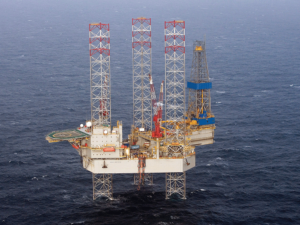
 At Noble Corp, the contractor reports seeing an uptick of interest for floaters and jackups in the North Sea, as well as a 20% to 30% improvement in dayrates. Robert Eifler, Vice President and General Manager Marketing and Contracts with Noble, attributes this to Brent oil prices north of $70/bbl and large E&P companies selling assets to smaller independent firms, which have opened up new drilling plans.
At Noble Corp, the contractor reports seeing an uptick of interest for floaters and jackups in the North Sea, as well as a 20% to 30% improvement in dayrates. Robert Eifler, Vice President and General Manager Marketing and Contracts with Noble, attributes this to Brent oil prices north of $70/bbl and large E&P companies selling assets to smaller independent firms, which have opened up new drilling plans.
Once smaller independents close these transactions, they tend to move quickly to drill and often react more quickly to oil price shifts compared with larger E&P firms. Noble believes the market improvement will extend into 2019 but thinks the jury is still out for 2020 on whether the market upswing is sustainable.
The company currently has three jackups operating in the UK and Danish North Sea. The Noble Lloyd Noble is drilling for Equinor in the UK North Sea through late November 2020. The Noble Sam Turner is working in the Danish North Sea for Total, and the Noble Hans Deul is drilling for Spirit Energy in the UK North Sea. Noble is also planning to mobilize a rig into the region – the Noble Houston Colbert, which is currently working for Dolphin Energy in Qatar, will commence a six-month contract in May 2019 for an undisclosed operator in the UK North Sea.
To cope with the downturn, Noble has worked with its customers to realign drilling schedules and eliminate gaps in rig downtime wherever possible. The contractor has also sought the right balance of rig personnel that would facilitate cost reduction while allowing the company to restart operations quickly if work opportunities arose, Mr Eifler said.
Further, Noble and the entire drilling industry are transforming into a more performance-based culture, he added. Technology – much of it data-driven – will enable the industry to move toward this new mentality. As part of this shift, Noble has partnered with GE to outfit four high-specification rigs with an advanced data analytics system that can detect performance anomalies and possible failures weeks in advance. By monitoring seven systems – the BOP system, power system, drawworks, mud pumps, top drive, thrusters and dynamic positioning system – Noble expects to achieve improved reliability and up to a 20% reduction in maintenance costs associated with these major rig components on these rigs.
Opportunities remain for operators
Although the low-hanging fruit has been picked, opportunities still exist for operators to bring new production online through existing North Sea infrastructure.

Apache’s North Sea strategy is a returns-focused investment program to sustain production and cash flow from its Forties and Beryl area fields, which includes step-out drilling with subsea tieback opportunities for the company’s operated facilities, said Jon Graham, Region Vice President and Managing Director for Apache North Sea.
The company currently has two platform rigs drilling development wells on the Forties and Beryl fields. In mid-June, the company planned to take Diamond Offshore’s Ocean Patriot semi under a two-year contract with options. Apache will use the rig to drill one to two development wells at its Callater field in the Beryl area, then move it to the Garten discovery for completions work.
As it did in 2017, Apache plans to drill 14 wells in the UK North Sea this year, with 10 platform wells and four subsea wells. While the company will satisfy its semi drilling contract requirements with the Ocean Patriot, it may have a drilling opportunity for a jackup at its Forties field, as well as for other projects in the 2019 and 2020 time period, Mr Graham said.
Apache has sustained its success of finding bypass oil and migration in the Forties reservoir – something that Mr Graham credits to the company’s use of 4D seismic monitoring and new ocean-bottom data acquisitions made in 2012 and 2013, along with its integrated team of geoscientists and reservoir engineers.
Since Apache entered the North Sea in 2003, it has drilled more than 120 wells on the Forties field. Based on its latest 4D seismic survey, Apache has identified more than 50 undrilled locations within the Forties field area. This year, the company plans to drill eight to 10 platform development wells and three to four subsea development and exploratory wells from this inventory. “In the Forties field, it’s such a quality reservoir, and we’re able to use our seismic techniques to identify upswept areas or migrated oil that is gone to new areas that generate anywhere from 500,000- to 1 million-bbl type targets,” Mr Graham said.
Apache also relied on modern 3D seismic to identify previously unrecognizable accumulations with the Garten discovery in the Beryl area, which the company announced earlier this year. Garten encountered more than 700 ft of net oil pay in stacked, high-quality Jurassic-aged sandstone reservoirs. Apache plans to tie back Garten to the Beryl Alpha platform and expects to bring Garten on production as soon as Q4 2018.
The company’s smart well completion strategy will enable three reservoir areas to be managed with one completion. The strategy calls for using a series of hydraulically controlled valves and feed-through isolation packers to control selectivity for producing multiple zones in a well. Doing so enables improved reservoir management through discrete long-term production and shut-in cycles with real-time downhole pressures and temperatures.
“We can go from one zone to the other with sliding sleeves with data gathering as far as temperatures and pressures,” Mr Graham said. Although smart technologies have been used on some of Apache’s acquired deepwater installations, the North Sea is the only region where the company is actively utilizing this strategy.
Apache is also finding new opportunities on the Forties field, which produces 34,000 bbl of oil equivalent per day (boed) net to Apache’s interest. Since coming on production in 1975, the field has cumulatively produced more than 2 billion bbl of oil.
A mix of technology, LEAN exercises, financial investment in assets and contractor alliances has allowed Apache to maintain production efficiency of its platforms and wells at 90% or more and hold down operating costs below $20/bbl.
Given that most of Apache’s costs are people-related, the company is also looking at ways to improve efficiency while not sacrificing safety or environmental responsibility, Mr Graham said. “About 70% of our workforce is contractors, so we spend a lot of time making sure we’re aligned with our contractors, making sure they understand our expectations, rules and how we go about our business,” said Mr Graham, noting that Apache has long-term relationships with most of its offshore contractors.
Norway-focused independent Aker BP expects to operate five to six rigs this year and through 2019, said Tommy Sigmundstad, SVP Drilling and Wells. Beyond 2020, the company expects to at least maintain the current level of rigs, depending on which projects are sanctioned by the Norwegian government.
During 2018, the company will have four rigs under contract, in addition to the Valhall IP platform rig. Maersk Drilling’s Maersk Interceptor jackup, contracted out to December 2019, was drilling the Hanz appraisal well on the Ivar Aasen field as of early June. The Maersk Invincible jackup, whose contract runs through April 2022, is plugging and abandoning wells on an old drilling platform at Valhall, which consists of a field center with six platforms and two unmanned flank platforms. After completing this P&A work, the rig will move to the North Flank of Valhall to drill production wells in Q4 2018.
Odfjell Drilling’s Deepsea Stavanger is drilling an exploration well for Aker BP in the Barents Sea before moving to a production well in the Alvheim area of the North Sea. Options for the Deepsea Stavanger would keep the rig contracted to the operator through mid-2020. Finally, the Scarabeo 8 is scheduled to start drilling a well in the Alvheim area in Q3 this year. In addition to these rigs, Aker BP says it also plans to hire a floater rig to conduct exploration and production drilling in Q3 2018.
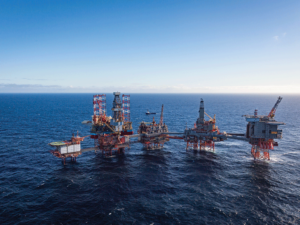
 Aker BP – which was created in late 2016 – purposefully invested in offshore Norway during the oil price downturn. It initially focused on production growth through M&A; as of Q1 2018, its production had risen to 158,600 boepd. Going forward, the company will focus more on exploration and increasing oil recovery, Mr Sigmundstad said. In the North Sea, the company will focus this year on increasing production from its existing hubs – Alvheim, Ula and Valhall – while identifying potential new core areas through exploration in both the North Sea and Barents Sea.
Aker BP – which was created in late 2016 – purposefully invested in offshore Norway during the oil price downturn. It initially focused on production growth through M&A; as of Q1 2018, its production had risen to 158,600 boepd. Going forward, the company will focus more on exploration and increasing oil recovery, Mr Sigmundstad said. In the North Sea, the company will focus this year on increasing production from its existing hubs – Alvheim, Ula and Valhall – while identifying potential new core areas through exploration in both the North Sea and Barents Sea.
During 2018, Aker BP plans to drill or participate in the drilling of five North Sea exploration wells. One of these wells is the Frosk exploration well near Alvheim, where the operator reported an exploration success in February. The discovery is estimated to be between 30 million boe and 60 million boe, which would be significantly higher than the company’s pre-drill estimate of 3 million boe to 21 million boe.
With exploration and production activity rising, Aker BP is also intent on controlling costs. From a per-barrel operating expenditure standpoint, the company is focusing on new projects with breakevens below $35/bbl that give it a 10% return on investment. Last year, the company was able to deliver wells with drilling expenditures below $6/boe, Mr Sigmundstad said.
To meet its goals of achieving greater production and efficiency at lower cost, the company has identified six enablers, including the implementation of digital technology. Through its digitalization team, the Aker BP Drilling & Wells team is looking at four streams, which include data architecture and data flow, as well as well planning, where the goal is to design a well in a day and create a digital twin of that well for monitoring purposes. The company has not yet implemented digital twins into its operations, but Aker BP hopes to let the digital twin run certain operations autonomously by the end of 2019.
Next year – as part of its third digitalization stream – Aker BP hopes to transition from semi-automated drilling to an autonomous drilling rig, with sensors and algorithms to update a well’s digital twin and machine learning to model drilling and allow optimum performance. The fourth enabler is focused on building the right kind of worker competency needed within the company.
The biggest challenge of moving from semi-automated to fully automated drilling is not technology, Mr Sigmundstad said, but that Aker BP must come together with control systems vendors, rig owners, third-party equipment and software suppliers to agree on commercial terms and contracts, warranties and liabilities.
Aker BP believes its alliances with Maersk Drilling and Odfjell Drilling can address this challenge. In November 2017, Aker BP formed alliances with Maersk and Halliburton for jackups, and Odfjell and Halliburton for semis, to create a new model for drilling wells and compensation. The alliances – which have five-year frame agreements plus options for another five years – will ensure operators and contractors are all pulling in the same direction on compensation.
Prior to the alliances, the company already had been working closely with Maersk and Odfjell to create greater efficiencies in the drilling process. This effort has paid off, with Aker BP expecting to use one to two fewer rigs today than it initially planned a year ago, Mr Sigmundstad said. DC


